|
| Method no.: |
1005 |
| |
|
| Control no.: |
T-1005-FV-01-0111-M |
| |
|
| Target Concentration: |
1 ppm |
| |
|
| OSHA PEL: |
1 ppm (3.19 mg/m³)(TWA); 5
ppm (16.0 mg/m³)(15-min STEL); 50 ppm (160 mg/m³)(10-min Peak) in
General Industry (29 CFR 1910.1028)
10 ppm (31.9 mg/m³)(TWA); 25
ppm (79.8 mg/m³)(15-min Ceiling) in sectors excluded from General
Industry (29 CFR 1926.1028)
1 ppm (3.19 mg/m³)(TWA); 5 ppm (16.0
mg/m³)(15-min STEL); 50 ppm (160 mg/m³)(10-min Peak) in Shipyard and
Construction Industries |
| |
|
| ACGIH TLV: |
0.5 ppm (1.6 mg/m³) TWA; 2.5
ppm (8.0 mg/m³)(15-min STEL) (Skin) Enter Information. |
| |
|
| Procedure: |
Active samples are collected
by drawing workplace air through charcoal tubes with personal
sampling pumps. Diffusive samples are collected by exposing either
SKC 575-002 Passive Samplers or 3M 3520 Organic Vapor Monitors (OVM)
to workplace air. Samples are extracted with carbon disulfide and
analyzed by GC using a flame ionization detector (FID). |
| |
|
Recommended air volume
and
sampling rate:
Charcoal tubes: |
240 min at 50 mL/min (12
L)(TWA); 10 min at 50 mL/min (0.5 L)(Peak);
15 min at 50 mL/min
(0.75 L)(STEL) |
| |
|
SKC 575-002 Passive
Sampler
and 3M 3520 OVM: |
240 min (TWA); 10 min
(Peak); 15 min (STEL) (Note: SKC 575-002 Passive Samplers and 3M
3520 OVMs must be exposed for at least 10 min) |
| |
|
| Reliable
quantitation limit (RQL) and standard error of estimate (SEE): |
|
| Media |
RQL |
SEE |
|
(ppb) |
(µg/m³) |
(%) |
|
| Charcoal tube |
3.32 |
11 |
5.1 |
| SKC 575-002 Passive Sampler |
4.25 |
14 |
8.8 |
| 3M 3520 OVM |
3.55 |
11 |
7.4 |
| |
| *For samples
where sampling site atmospheric pressure and temperature are known.
When either or both of these values are unknown, see Section 4.4 for
applicable standard errors of estimate. |
| |
| Special
requirements: |
Report sampling site
atmospheric pressure and temperature when using diffusive
samplers. |
| |
|
| Wipe sampling: |
A 10 cm × 10 cm area is
wiped with the charcoal pad from 3M 3520 OVM and immediately placed
into a capped vial. |
| |
|
| Status of
method: |
Evaluated method. This
method has been subjected to the established evaluation procedures
of the Methods Development Team. |
| |
|
| Date: |
November 2001 |
| |
|
| Revised: |
September 2002 |
| |
|
| Chemist: |
Mary E. Eide |
| |
|
Methods Development Team
Industrial Hygiene Chemistry
Division
OSHA Salt Lake Technical Center
Sandy UT
84070-6406
|
1. General
Discussion
1.1 Background
1.1.1 History
The
collection of benzene using charcoal tubes (SKC lot 107) was
evaluated in OSHA Method 12.1 Since that time, many
diffusive samplers have come on the market, and are becoming
more popular for workplace sampling. The Methods Development
Team at OSHA Salt Lake Technical Center is in the process of
validating passive samplers for the top 10 organic chemicals.
Benzene is in the top 10 organic chemicals requested, therefore
an evaluation of its sampling performance with passive samplers
was performed. This method includes two diffusive samplers, SKC
575-002 Passive Samplers and 3M 3520 OVMs, along with charcoal
tubes (SKC lot 2000). Benzene PELs include a TWA, STEL, Ceiling,
and Peak; therefore, these media were evaluated for both short
term and long term sampling, for the various PELs.
The
tests for the determination of the sampling rate show that SKC
575-002 Passive Samplers and 3M 3520 OVMs had a faster sampling
rate in the first five minutes of sampling, than the rest of the
times sampled. The sampling rate for the subsequent time periods
each decreased until at 30 minutes it leveled off to the
sampling rate used. The sampling rate was significantly higher
in the first 5 minutes of sampling than the rest of the sampling
period, so it is recommended that the sampling time for these
passive samplers be at least 10 minutes. The Peak PEL for
benzene is defined as a 10-minute sample.
Each of the
media had good extraction efficiency and storage stability. The
use of a capillary column in the analysis allowed for lower
reliable quantitation limits in this method when compared to the
limits obtained with the packed column in OSHA Method
12.2
1.1.2 Toxic effects (This section is for
information only and should not be taken as the basis of OSHA
policy.)
Benzene in high concentrations has narcotic
effects similar to toluene and other aromatics. Benzene is a
myclotoxicant known to suppress bone marrow cell proliferation
and to induce hematologic disorders in humans and animals.
Chronic exposure to benzene leads to aplastic anemia, and may
lead to leukemia after 6 months to 6 years of chronic exposure.
Benzene exposure can cause chromosomal aberrations in animals
and humans. Chronic benzene exposure has also been associated
with lung cancer in epidemiological studies. Benzene is
classified as a human carcinogen by American Conference of
Governmental Industrial Hygienists (ACGIH) and International
Agency for Research on Cancer (IARC).³ Benzene is classified as
a suspected human carcinogen by OSHA.4 A risk
assessment for benzene exposure performed by Rinsky et al.,
reported that a worker exposed to 10 ppm benzene for 40 years
was 155 times more likely to die from leukemia than an unexposed
worker. A worker exposed to 1 ppm benzene was 1.7 times more
likely to die from leukemia than an unexposed
worker.5 IARC has published a risk assessment showing
that workers exposed to a 10 ppm chronic exposure, had an
increase of 14-140 leukemia cases per 1000 people above the rate
for an unexposed worker. For 1 ppm chronic exposure, there was
an increase of 1.4-14 cases per 1000 above the rate for an
unexposed worker.6 The skin notation cited in the TLV
is based on the skin absorption rate of 0.05% when neat benzene
is applied to the skin, indicating benzene exposures through
skin absorption can be significant.7
1.1.3
Workplace exposure
Benzene is used in the manufacture of
industrial chemicals, as a solvent for waxes, resins, oils,
natural rubber. Benzene may be present in gasoline and other
petroleum products up to 1%, as a natural part of the cracking
process.8 Benzene was the 16th highest
chemical in the ranking of production by volume for
1995.9 Benzene production was 2.412 billion gallons
in 2000.10
1.1.4 Physical properties and
descriptive information11,12,13
CAS
number:
IMIS number14:
molecular
weight:
boiling point:
melting point:
specific
gravity:
|
71-43-2
0320
78.11
80.1°C
5.5°C
0.879
at 20°C
|
vapor
pressure:
lower explosive limit:
flash
point:
odor:
appearance:
molecular
formula: |
10 kPa at
20°C
1.5 to 8% by volume
11°C (52°F)
(cc)
characteristic aromatic
colorless
liquid
C6H6 |
| synonyms: |
benzol;
coal naphtha; cyclohexatriene; phenyl hydride |
| solubility: |
slightly soluble in water; miscible in alcohol,
acetone. carbon disulfide, carbon tetrachloride,
chloroform, ether, glacial acetic acid, and oils |
| structure: |
 |
|
| This method was evaluated
according to the OSHA SLTC "Evaluation Guidelines for Air
Sampling Methods Utilizing Chromatographic
Analysis"15. The Guidelines define analytical
parameters, specify required laboratory tests, statistical
calculations and acceptance criteria. The analyte air
concentrations throughout this method are based on the
recommended sampling and analytical parameters. Air
concentrations listed in ppm are referenced to 25°C and 101.3
kPa (760 mmHg). |
|
1.2 Limit defining
parameters
1.2.1 Detection limit of the
analytical procedure
The detection limit of the
analytical procedure is 3.12 pg. This is the amount of analyte
that will give a detector response that is significantly
different from the response of a reagent blank. (Section
4.1)
1.2.2 Detection limit of the overall
procedure
The detection limits of the overall procedure
are 38 ng/sample for charcoal tubes, 49 ng/sample for SKC
575-002 Passive Samplers, and 41 ng/sample for 3M 3520 OVMs.
These are the amounts of benzene spiked on the respective
sampler that will give detector responses that are significantly
different from the responses of respective sampler blanks.
(Section 4.2)
Table 1.2.2
Detection Limits of
the Overall Procedure
|
| sampler |
ng |
ppb |
µg/m³ |
|
charcoal tube
SKC 575-002
3M 3520 |
38
49
41 |
0.99
1.28
1.07 |
3.17
4.08
3.42 |
|
1.2.3 Reliable quantitation
limit
The reliable quantitation limits are 127 ng per
sample (3.3 ppb or 11 g/m³) for charcoal tubes, 163 ng per
sample (4.3 ppb or 14 g/m³) for SKC 575-002 Passive Samplers,
and 136 ng per sample (3.6 ppb or 11 µg/m³) for 3M 3520 OVMs.
These are the amounts of benzene spiked on the respective
samplers that will give detector responses that are considered
the lower limits for precise quantitative measurements. (Section
4.2)
Table 1.2.3
Reliable Quantitation
Limits
|
| sampler |
ng |
ppb |
µg/m³ |
EE |
|
charcoal
tube
SKC 575-002
3M 3520 |
127
163
136 |
3.32
4.26
3.55 |
10.6
13.6
11.3 |
96.6
93.1
97.9 |
|
1.2.4
Instrument calibration
The standard error of estimate is
0.34 µg over the range of 9.9 to 79.1 µg. This range corresponds
to 0.25 to 2 times the TWA target concentration. (Section
4.3)
1.2.5 Precision
Charcoal Tubes
The
precision of the overall procedure at the 95% confidence level
for the ambient temperature 19-day storage test for samples
collected from a dynamically generated atmosphere of 1.2 ppm
(3.84 mg/m³) collected on charcoal tubes is ±9.94%. This
includes an additional 5% for sampling pump variability.
(Section 4.4)
SKC 575-002 Passive Samplers
The
precisions of the overall procedure at the 95% confidence level
for the ambient temperature 19-day storage test for samples
collected from a dynamically generated atmosphere of 1.2 ppm
(3.84 mg/m³) collected on SKC 575-002 Passive Samplers are given
in Table 1.2.5.1. They each include an additional 8.7% for
sampling rate variability. There are different values given,
depending on whether both, either, or neither temperature (T) or atmospheric pressure (P) are known at the sampling site. If the
sampling site temperature is unknown, it is assumed to be 22.2 ±
15°C (72 ± 27°F) and a variability of ±7.7% is included. If the
atmospheric pressure is not known, it is estimated from the
sampling site elevation and a variability of ±3% is included.
(Section 4.4)
Table 1.2.5.1
Precision of the
Overall Procedure
of SKC 575-002 Passive
Samplers
|
| know
conditions |
precision
(±%) |
|
both
T & P
only T
only P
neither T nor P |
17.2
18.1
22.8
23.6 |
|
3M 3520
OVMs
The precisions of the overall procedure at the 95%
confidence level for the ambient temperature 19-day storage test
for samples collected from a dynamically generated atmosphere of
1.2 ppm (3.84 mg/m³) collected on 3M 3520 OVMs are given in
Table 1.2.5.2. They each include an additional 6.4% for sampling
rate variability. There are different values given, depending on
whether both, either, or neither temperature (T) or atmospheric pressure (P) are known at the sampling site. If the
sampling site temperature is unknown, it is assumed to be 22.2 ±
15°C (72 ± 27°F) and a variability of ±7.7% is included. If the
atmospheric pressure is not known, it is estimated from the
sampling site elevation and a variability of ±3% is included.
(Section 4.4)
Table 1.2.5.2
Precision of Overall
Procedure for 3M 3520 OVMs
|
| know
conditions |
precision
(±%) |
|
both
T & P
only T
only P
neither T nor P |
12.6
13.9
19.6
20.6 |
|
1.2.6
Recovery
The recovery of benzene from samples used in a
19-day storage test remained above 98.0%, 96.5%, and 96.2% when
the samples were stored at 23°C for charcoal tubes, SKC 575-002
Passive Samplers, and 3M 3520 OVMs, respectively. (Section
4.5)
1.2.7 Reproducibility
Six samples for each of
the three types of samplers were collected from a controlled
test atmosphere and submitted for analysis by the OSHA Salt Lake
Technical Center. The samples were analyzed according to a draft
copy of this procedure after 7 days of storage at 4°C. No
individual sample result deviated from its theoretical value by
more than the precision reported in Section 1.2.5. (Section
4.6)
2.
Sampling Procedure
All safety practices that apply to the
work area being sampled should be followed. The sampling equipment
should be attached to the worker in a manner that will not interfere
with work performance or safety.
2.1 Apparatus
2.1.1 Charcoal
tubes
Samples are collected with 7-cm × 4-mm i.d. × 6-mm
o.d. glass sampling tubes packed with two sections of coconut
shell charcoal. The front section contains 100 mg and the back
section contains 50 mg of charcoal. The sections are held in
place with glass wool and polyurethane plugs. For this
evaluation, commercially prepared charcoal tubes were purchased
from SKC, Inc. (catalog no. 226-01, Anasorb CSC, lot
2000).
Samples are collected using a personal sampling
pump calibrated, with the sampling device attached, to within
±5% of the recommended flow rate.
2.1.2 SKC 575-002
Passive Samplers and 3M 3520 OVMs
Samples are collected
with either SKC 575-002 Passive Samplers, or with 3M 3520 OVMs.
Samplers were purchased from SKC, Inc. (catalog no. 575-002,
contains 500 mg of Anasorb 747) or from 3M (catalog no. 3520,
contains two charcoal adsorbent pads).
A thermometer and
barometer to determine the sampling site air temperature and
atmospheric pressure. 2.2
Reagents
None required
2.3 Technique
2.3.1 Charcoal
tubes
Immediately before sampling, break off the ends of
the flame-sealed tube to provide an opening approximately half
the internal diameter of the tube at each end. Wear eye
protection when breaking ends. Use tube holders to minimize the
hazard of broken glass. All tubes should be from the same
lot.
The smaller section of the adsorbent tube is used as
a back-up and is positioned nearest the sampling pump. Attach
the tube holder to the sampling pump so that the adsorbent tube
is in an approximately vertical position with the inlet facing
down during sampling. Position the sampling pump, tube holder
and tubing so they do not impede work performance or safety. Use
tube holder to minimize the hazard to the worker from the broken
end of the tube.
Draw the air to be sampled directly into
the inlet of the tube holder. The air being sampled should not
be passed through any hose or tubing before entering the
sampling tube.
After sampling for the appropriate time,
remove the adsorbent tube and seal it with plastic end caps.
Seal each sample end-to-end with an OSHA 21 form as soon as
possible.
Submit at least one blank sample with each set
of samples. Handle the blank sampler in the same manner as the
other samples except draw no air through it.
Record
sample air volume (liters), sampling time (minutes) and sampling
rate (mL/min) for each sample, along with any potential
interferences on the OSHA 91A form.
Submit the samples to
the laboratory for analysis as soon as possible after sampling.
If delay is unavoidable, store the samples in a refrigerator.
Ship any bulk samples separate from the air
samples.
2.3.2 SKC 575-002 Passive Samplers (In general,
follow the manufacturer's instructions.)
Remove the
sampler enclosed in an air-tight clear bag from the container,
just before sampling is to begin. Caution- The
sampler begins to sample immediately after the clear plastic bag
is opened. Keep the O-ring, press-on cover, cover
retainer, port plugs and PTFE tube for later use.
Record
the start time on the sampler label or on the OSHA 91A
form.
Attach the sampler to the worker near his/her
breathing zone with the perforations in the sampler facing
forward. Assure that the area directly in front of the sampler
is unobstructed throughout the sampling period.
At the
end of the sampling period, immediately detach the sampler from
the worker and attach the cover with the O-ring in place onto
the sampler using the cover retainer. Visually inspect the
O-ring to be sure it is forming a proper seal around the entire
circumference of the sampler. Record the stop time on sampler
label or on OSHA 91A form.
Prepare a blank by removing an
unused sampler from its clear package and immediately attaching
a cover with the O-ring in place onto it.
Seal each
sampler with an OSHA 21 form.
Verify that the sampling
times are properly recorded on the OSHA 91A form for each
sample. Also, identify blank samples on this form.
Record
the room temperature and atmospheric pressure of the sampling
site on the OSHA 91A form.
List any compounds that could
be considered potential interferences, especially solvents, that
are being used in the sampling area.
Submit the samples
to the laboratory for analysis as soon as possible after
sampling. If delay is unavoidable, store the samples in a
refrigerator. Ship any bulk samples separate from the air
samples. Include all port plugs and PTFE tubes which will be
used in the laboratory analyses. Ship any bulk sample(s) in a
container separate from the air samples.
2.3.3 3M OVMs
(In general, follow the manufacture's instructions supplied with
the samplers.)
The samplers come individually sealed in
small metal cans. When ready to begin sampling, remove the
plastic lid from the can and lift up on the revealed ring. Pull
back on the ring to open the can. Discard the metal top of the
can and remove the sampler. Caution - The
sampler begins to sample immediately after the can is
unsealed.
Keep the two closure caps with attached
port plugs, cup and PTFE tubes in the can for later use. Close
the can with the plastic lid.
Record the start time on
the back of the sampler or on the OSHA 91A form.
Attach
the sampler to the worker near his/her breathing zone with the
white face forward. Assure that the area directly in front of
the sampler is unobstructed throughout the sampling period. Do
not remove the white film and ring from the sampler until the
sampling period is terminated.
At the end of the sampling
period, detach the sampler from the worker and remove the white
film and retaining ring. Immediately snap a closure cap onto the
primary (top) section of the sampler (where the white film and
ring were removed). It is critical that this step be done as
quickly as possible because the sampling rate is more than five
times faster without the white film in place, which can be an
important consideration, especially for short-term sampling.
Assure that the attached port plugs are placed firmly into the
port holes. The white film and ring can be discarded. Record the
stop time on the back of the sampler and on the OSHA 91A
form.
The following steps should be performed in a low
background area for a set of samplers as soon as possible after
sampling.
Ready a blank by removing the white film and
ring and attaching a closure cap onto an unused
sampler.
For each sampler (one at a time), separate the
primary (top) and secondary (bottom) sections of the sampler
using the edge of a coin as a pry.
Securely snap a cup
onto the bottom of the primary section.
Snap a closure
cap onto the secondary section of the sampler and assure that
the attached port plugs are placed firmly into the port
holes.
Return the sampler sections with closure caps and
cup in place to the metal can which contains the PTFE tubes
(which will be used by the laboratory). Close the can with the
plastic lid, and seal it with an OSHA 21 form.
Verify
that the sampling times are properly recorded on OSHA 91A form
for each sample. Also, identify blank samples on this
form.
Record the room temperature and atmospheric
pressure of the sampling site on OSHA 91A form.
List any
compounds that could be considered potential interferences,
especially solvents, that are being used in the sampling
area.
Submit the samples to the laboratory for analysis
as soon as possible after sampling. If delay is unavoidable,
store the samples in a refrigerator. Ship any bulk samples
separate from the air samples. 2.4 Sampler capacity (Section 4.7)
2.4.1 Charcoal tubes
The
sampling capacity of the front section of a charcoal tube was
tested by sampling a dynamically generated test atmosphere of
benzene (73.4 mg/m³ or 23 ppm) at an absolute humidity of 15.7
milligrams of water per liter of air (about 80% relative
humidity at 22.2°C). The samples were collected at 50 mL/min. No
breakthrough was observed, even after sampling for 600
min.
2.4.2 SKC 575-002 Passive Samplers and 3M 3520
OVMs
The sampling rate and capacity of the SKC 575-002
Passive Sampler and the 3M 3520 OVM were determined by sampling
a dynamically generated test atmosphere of benzene (7.34 mg/m³
or 2.3 ppm and 73.4 mg/m³ or 23 ppm) at an absolute humidity of
15.7 milligrams of water per liter of air (about 80% relative
humidity at 22.2°C) for increasing time intervals. A sampling
rate of 17.1 mL/min for SKC 575-002 Passive Samplers and 34.3
mL/min for 3M 3520 OVM was determined. The recommended sampling
times for this method are 10 minutes for Peak, 15 minutes for
STEL, and 240 minutes for TWA sampling. The tests showed a
significant difference in the sampling rate for a 5 minute
sample versus the determined sampling rate, therefore, these
samplers cannot be used to sample for less than 10
minutes. 2.5 Extraction
efficiency (Section 4.8)
It is the responsibility of each
analytical laboratory to determine the extraction efficiency
because the adsorbent material, internal standard, reagents and
laboratory techniques may be different than the those listed in
this evaluation and influence the results.
2.5.1 Charcoal tubes
The
mean extraction efficiency for benzene from dry charcoal tubes
over the range of RQL to 2 times the target concentration (0.13
to 79.1 micrograms per sample) was 97.0%. The extraction
efficiency was not affected by the presence of water (average
recovery of 96.7%).
Extracted samples remain stable for
at least 24 h.
2.5.2 SKC 575-002 Passive
Samplers
The mean extraction efficiency for benzene from
dry SKC 575-002 Passive Samplers over the range of RQL to 2
times the target concentration (0.13 to 24.6 micrograms per
sample) was 93.6%. The extraction efficiency was not affected by
the presence of water (average recovery of
93.9%).
Extracted samples remain stable for at least 24
h.
2.5.3 3M 3520 OVMs
The mean extraction
efficiency for benzene from dry 3M 3520 OVMs over the range of
RQL to 2 times the target concentration (0.13 to 54.5 micrograms
per sample) was 97.9%. The extraction efficiency was not
affected by the presence of water (average recovery of
98.1%).
Extracted samples remain stable for at least 24
h. 2.6 Recommended
sampling time and sampling rate
2.6.1 Charcoal
tubes
Sample with charcoal tubes for up to 240 min at 50
mL/min (12 L) to collect TWA (long-term) samples, for 10 min at
50 mL/min (0.5 L) to collect Peak (short-term) samples, and for
15 min at 50 mL/min (0.75 L) collect STEL (short-term)
samples.
When short-term samples are collected, the air
concentration equivalent to the reliable quantitation limit
becomes larger. For example, the reliable quantitation limit for
charcoal tubes is 0.05 ppm (0.17 mg/m³) for benzene when 0.75 L
are collected.
2.6.2 SKC 575-002 Passive
Samplers
Sample with SKC 575-002 Passive Samplers for up
to 240 min to collect TWA (long-term) samples, for 10 min to
collect Peak (short-term) samples, and for 15 min to collect
STEL (short-term) samples. The sampling rate is 17.1
mL/min.
When short-term samples are collected, the air
concentration equivalent to the reliable quantitation limit
becomes larger. For example, the reliable quantitation limit for
SKC 575-002 Passive Samplers is 0.20 ppm (0.64 mg/m³) for
benzene when 0.26 L (15 min) are collected.
2.6.3 3M 3520
OVMs
Sample with 3M 3520 OVMs for up to 240 min to
collect TWA (long-term) samples, for 10 min to collect Peak
(short-term) samples, and for 15 min to collect STEL
(short-term) samples. The sampling rate is 34.3
mL/min.
When short-term samples are collected, the air
concentration equivalent to the reliable quantitation limit
becomes larger. For example, the reliable quantitation limit for
3M 3520 OVMs is 0.08 ppm (0.26 mg/m³) for benzene when 0.51 L
(15 min) are collected. 2.7 Interferences, sampling (Section 4.9)
2.7.1 Charcoal
tubes
Retention
The mean retention efficiency for
all samples was 100.4%, when charcoal tubes containing 880 g of
benzene were allowed to sample 9 L of contaminant-free air
having an absolute humidity of 15.7 milligrams of water per
liter of air (about 80% relative humidity at 22.2°C).
Low
humidity
The ability of a charcoal tube to collect
benzene from a relatively dry atmosphere was determined by
sampling an atmosphere of two times the target concentration of
benzene and having an absolute humidity of 1.9 milligrams of
water per liter of air (about 10% relative humidity at 22.2°C).
The samples collected above 99.7% of theoretical.
Low
concentration
The ability of a charcoal tube to collect
benzene at low concentrations was determined by sampling a test
atmosphere containing 0.1 times the target concentration of
benzene and having an absolute humidity of 15.7 milligrams of
water per liter of air (about 80% relative humidity at 22.2°C).
The samples collected above 98.5% of
theoretical.
Interference
The ability of charcoal
tubes to collect benzene in the presence of an interference was
determined from a test atmosphere containing one times the
target concentration of benzene, 890 mg/m³ of gasoline, and
having an absolute humidity of 15.7 milligrams of water per
liter of air (about 80% relative humidity at 22.2°C). The
benzene concentration on the samples remained above 98.9% of
theoretical.
2.7.2 SKC 575-002 Passive
Samplers
Reverse diffusion
Reverse diffusion is
the measure of the ability of the sorbent within a diffusive
sampler to retain the analyte collected. Reverse diffusion is
measured by first exposing two sets of samplers to humid air
containing the analyte, and then additionally exposing one of
the sets to clean humid air of an absolute humidity of 15.7
milligrams of water per liter of air (about 80% relative
humidity at 22.2°C). Comparison of the two sets of 3M 3520 OVMs
showed that an average of 99.1% of the benzene was retained,
indicating a loss of 0.9% to reverse diffusion. The loading of
benzene on the samplers was 75.3 µg. (Section 4.9.2)
Low
humidity
The ability of a SKC 575-002 Passive Sampler to
collect benzene from a relatively dry atmosphere was determined
by sampling an atmosphere of two times the target concentration
of benzene and having an absolute humidity of 1.9 milligrams of
water per liter of air (about 10% relative humidity at 22.2°C).
The samples collected above 98.9% of theoretical.
Low
concentration
The recovery for all samples was above
98.7% of theoretical, when SKC 575-002 Passive Samplers were
used to sample a test atmosphere containing 0.1 times the target
concentration of benzene and having an absolute humidity of 15.7
milligrams of water per liter of air (about 80% relative
humidity at 22.2°C).
Interference
The ability of
SKC 575-002 Passive Samplers to collect benzene in the presence
of an interference was determined from a test atmosphere
containing one times the target concentration of benzene, 890
mg/m³ of gasoline, and having an absolute humidity of 15.7
milligrams of water per liter of air (about 80% relative
humidity at 22.2°C). The benzene concentration on the samples
remained above 99.3% of theoretical.
2.7.3 3M 3520
OVMs
Reverse diffusion
Reverse diffusion is the
measure of the ability of the sorbent within a diffusive sampler
to retain the analyte collected. Reverse diffusion is measured
by first exposing two sets of samplers to humid air containing
the analyte, and then additionally exposing one of the sets to
clean humid air of an absolute humidity of 15.7 milligrams of
water per liter of air (about 80% relative humidity at 22.2°C).
Comparison of the two sets of 3M 3520 OVMs showed that an
average of 99.2% of the benzene was retained, indicating a loss
of 0.8% to reverse diffusion. The loading of benzene on the
samplers was 75.3 µg. (Section 4.9.3)
Low
humidity
The ability of 3M 3520 OVMs to collect benzene
from a relatively dry atmosphere was determined by sampling an
atmosphere of two times the target concentration of benzene and
having an absolute humidity of 1.9 milligrams of water per liter
of air (about 10% relative humidity at 22.2°C). The samples
collected above 98.7% of theoretical.
Low
concentration
The ability of 3M 3520 OVMs to collect
benzene at low concentrations was determined by sampling a test
atmosphere containing 0.1 times the target concentration of
benzene and having an absolute humidity of 15.7 milligrams of
water per liter of air (about 80% relative humidity at 22.2°C).
The samples collected above 99.5% of
theoretical.
Interference
The ability of 3M 3520
OVMs to collect benzene in the presence of an interference was
determined from a test atmosphere containing one times the
target concentration of benzene, 890 mg/m³ of gasoline, and
having an absolute humidity of 15.7 milligrams of water per
liter of air (about 80% relative humidity at 22.2°C). The
benzene concentration on the samples remained above 99.1% of
theoretical. 3.
Analytical Procedure
Adhere to the rules set down in your
Chemical Hygiene Plan16. Avoid skin contact and
inhalation of all chemicals and review all MSDSs before beginning
this analytical procedure.
3.1 Apparatus
3.1.1 Gas chromatograph equipped
with an FID. A Hewlett-Packard Model 5890 Series II GC equipped
with an integrator, an automatic sample injector, and an FID was
used in this evaluation.
3.1.2 A GC column capable of
separating benzene from the extracting solvent, internal
standard, and the components of gasoline. A J&W 60-m ×
0.32-mm i.d. DB-1 (5-µm df) capillary column was used in this
evaluation.
3.1.3 An electronic integrator or other
suitable means of measuring GC detector response. A Waters
Millenium32 Data System was used in this evaluation,
along with a Hewlett Packard 3396 Series II
integrator.
3.1.4 Glass vials with PTFE-lined caps. For
this evaluation 2 and 4-mL vials were used.
3.1.5 A
dispenser capable of delivering 1.0 or 2.0 mL of extracting
solvent to prepare standards and samples. If a dispenser is not
available, 1.0- and 2.0-mL volumetric pipets may be
used.
3.1.7 Volumetric flasks - 10-mL and other
convenient sizes for preparing standards.
3.1.8
Calibrated 10-L syringe for preparing standards.
3.1.9 An
SKC Desorption shaker with rack (226D-03K) was used to extract
SKC 575-002 Passive Samplers in this evaluation.
3.1.10 A
mechanical shaker. An Eberbach mechanical shaker was used to
extract the charcoal tubes in this evaluation.
3.2 Reagents
3.2.1 Benzene, [CAS no.
71-43-2], reagent grade or better. The benzene used in this
evaluation was A.C.S. reagent grade (lot no. CU 03251PS)
purchased from Aldrich (Milwaukee, WI).
3.2.2 Carbon
disulfide (CS2), [CAS no. 75-15-0], reagent grade or
better. The carbon disulfide used in this evaluation was 99.9+%
low benzene content grade (lot no. TI 01762PI) purchased from
Aldrich (Milwaukee, WI).
3.2.3 1-Phenylhexane
(n-hexylbenzene) [CAS no. 1077-16-3], reagent grade or better.
The 1-phenylhexane used in this evaluation was 97% reagent grade
(lot no. 03006PZ) purchased from Aldrich (Milwaukee,
WI).
3.2.4 The extraction solvent used for this
evaluation consisted of 0.25 L/mL n-hexylbenzene
(1-phenylhexane) in the CS2. The n-hexylbenzene was
added to the CS2 as an internal standard. Other
internal standards can be used provided they are fully
tested. 3.3 Standard
preparation
3.3.1 Prepare concentrated stock
standards of benzene in the extracting solvent. At least two
separate stock standard should be prepared. Prepare working
analytical standards by diluting these stock standards with the
extracting solution delivered from the same dispenser used to
extract the samples. For example, to prepare a target standard
(1 ppm), inject 4.5 L of benzene in a 10-mL volumetric flask
containing the extracting solvent and then make a 1/10 dilution
with the extracting solvent to obtain the working standard at
the target level. A second set of standards from a different
primary standard should be prepared to check the quality of the
first set of standards.
3.3.2 Bracket sample
concentrations with standard concentrations. If upon analysis,
sample concentrations fall outside the range of prepared
standards, prepare and analyze additional standards to confirm
instrument response, or dilute high samples with extraction
solvent and reanalyze the diluted samples.
3.4 Sample preparation
3.4.1 Charcoal
tubes
Remove the plastic end caps from the sample tube
and carefully transfer each section of the adsorbent to separate
2-mL vials. Discard the glass tube and glass wool and
polyurethane plugs.
Add 1.0 mL of extracting solution to
each vial and immediately seal the vials with PTFE-lined
caps.
Shake the vials on a shaker for 30 min (Shaking is
necessary to obtain the extraction efficiency found in this
method; without shaking the extraction efficiencies will be
lower.)
3.4.2 SKC 575-002 Passive Samplers (In general,
follow the manufacturer's instructions.)
Cut off the ends
of the two protruding tubes of each sampler with a razor blade
or sharp knife.
Slowly add 2.0 mL of extraction solvent
through one of the protruding tubes (ports), stopping at least
once to allow the bubbling to subside before adding the rest of
the extraction solvent.
Immediately insert plugs into the
ports.
Mount the samplers in the sampler rack (SKC Cat.
No. 226-04-5) of a specialized shaker (SKC Cat. No. 226D-03-1)
and shake the samplers for 1 hour.
Do not leave the
extracted sample in the sampler. Transfer each extracted sample
by removing the plugs from the sampler ports, firmly inserting
the tapered end of a supplied PTFE tube into the outer port and
carefully pouring the solution through the PTFE tube into a
labeled autosampler vial. Immediately cap each
vial.
3.4.3 3M 3520 OVMs (In general, follow the
manufacturer's instructions.)
Remove both sampler
sections from the metal cans, along with the sections of PTFE
tubing. Assure that the closure caps are firmly snapped to the
primary and secondary sections of all the samplers. Also assure
that all cap plugs are firmly seated in the cap ports. Any
deviations must be noted. Make sure each section of the sampler
is labeled properly for future reference.
Prepare one
section of sampler at time by temporarily removing the cap plugs
from the ports and adding 2.0 mL of extraction solvent through
the center port. Immediately replace the plugs in the ports.
Repeat the process for the second section.
Allow the
sampler sections to extract for 30 min. Periodically apply
gentle agitation to the sampler sections during the extraction
period.
Do not leave the extracted sample in the sampler.
Transfer the solution from each sampler section by removing both
plugs from the ports, inserting a decanting spout (a small
section of PTFE tubing) into the rim port and pouring the liquid
through the spout into a labeled autosampler vial. Immediately
cap each vial. 3.5
Analysis
3.5.1 Analytical
conditions
GC conditions
|
|
|
| column temperature:
|
initial 60°C, hold
5 min, program at 10°/min to 220°C, hold 14 min |
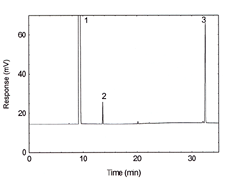
Figure 3.5.1. Chromatogram obtained at the
target concentration with the recommended analytical
conditions. There are three peaks: carbon disulfide at
9.26 min, benzene at 13.66 min, and n-hexyl benzene at
32.491 min. |
| zone temperatures:
|
220°C
(injector)
240°C (detector) |
| run time: |
35 min |
| column gas flow:
|
2.4 mL/min
(hydrogen) |
| septum purge: |
3.5 mL/min
(hydrogen) |
| injection size: |
1.0 µL (19:1
split) |
| column: |
60-m × 0.32-mm i.d.
capillary DB-1 (df = 5.0 µm) |
| retention times:
|
9.26 min (carbon
disulfide)
13.66 min (benzene)
32.491 min (n-hexyl
benzene) |
|
FID conditions
|
|
| hydrogen flow: |
35 mL/min |
| air flow: |
450 mL/min |
| nitrogen makeup
flow: |
35 mL/min |
|
|
|
3.5.2 An internal standard (ISTD) calibration
method is used. The calibration curve was constructed by
plotting the ISTD-corrected response of standard injections
versus micrograms of analyte per sample. Bracket the samples
with freshly prepared analytical standards over a range of
concentrations.
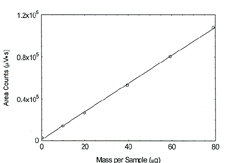 |
| Figure 3.5.2. A plot of the
calibration standards with mass per sample on the X axis
and area counts on the Y axis. The points plotted here
are: 79.1 µg , 107853 area counts; 59.3 µg , 80377 area
counts; 39.5 µg , 53375 area counts; 19.8 µg , 26661 area
counts; and 9.9 µg , 14246 area counts. (y = 1356x +
199) | 3.6
Interferences (analytical)
3.6.1 Any compound that produces
an FID response and has a similar retention time as the analyte
or internal standard is a potential interference. If any
potential interferences were reported, they should be considered
before samples are extracted. Generally, chromatographic
conditions can be altered to separate an interference from the
analyte.
3.6.2 When necessary, the identity of an analyte
peak may be confirmed with additional analytical data (Section
4.10). 3.7
Calculations
3.7.1 Charcoal tubes
The
amount of benzene per sampler is obtained from the appropriate
calibration curve in terms of micrograms per sample, uncorrected
for extraction efficiency. The back section is analyzed
primarily to determine the extent of sampler saturation. (The
charcoal tube is considered saturated when 25% of the amount
found on the front section is found on the back section of the
tube, and therefore, some of the sample may have been lost.) If
any analyte is found on the back section, it is added to the
amount on the front section. This total amount is then corrected
by subtracting the total amount (if any) found on the blank. The
air concentration is calculated using the following
formulas.
|
|
where |
CM is concentration by
weight (mg/m³) |
|
M is micrograms per sample |
|
V is liters of air sampled |
|
EE is extraction
efficiency, in decimal form |
|
|
where |
CV is concentration by
volume (ppm) |
|
VM = 24.46 at NTP |
|
CM is concentration by
weight |
|
Mr is molecular weight of
78.11 |
3.7.2 3M
3520 OVMs and SKC 575-002 Passive Samplers
The amount of
benzene for the samples is obtained from the appropriate
calibration curve in terms of micrograms per sample, uncorrected
for extraction efficiency. (In the case of the 3M 3520 OVMs, the
back section is analyzed primarily to determine the extent of
sampler saturation. If any analyte is found on the back section,
the amount is multiplied by 2.2 (as per manufacturer's
instructions) and then added to the amount on the front section.
The sampler is saturated, affecting its ability to collect, when
the corrected amount found on the back section is 50% of the
amount found on the front section.) This total amount is then
corrected by subtracting the total amount (if any) found on the
blank. The air concentration is calculated using the following
formulas.
| RSS =
RNTP |
( |
TSS
TNTP |
) |
3
2 |
( |
PNTP
PSS |
) | |
where |
RSS is the sampling rate at
sampling site |
|
RNTP is the sampling rate
at NTP conditions (SKC 575-002 = 17.1 mL/min, 3M OVM =
34.3 mL/min) |
|
TSS is the sampling site
temperature in K |
|
TNTP is 298.2 K |
|
PSS is the sampling site
pressure in mmHg |
|
PNTP is 760
mmHg |
|
|
where |
CM is concentration by
weight (mg/m³) |
|
M is
micrograms per sample |
|
RSS is the sampling rate at
the sampling site |
|
t is
the sampling time |
|
EE is extraction
efficiency, in decimal form |
|
|
where |
CV is concentration by
volume (ppm) |
|
VM = 24.46 at NTP |
|
CM is concentration by
weight |
|
Mr is molecular weight of
78.11 |
If
the sampling site temperature is not provided, assume that it is
22.2°C. If the sampling site atmospheric pressure is not given,
calculate an approximate value based on the sampling site
elevation from the following equation.
| PSS = AE² - BE +
760.0 |
where |
PSS is the approximate
atmospheric pressure |
|
E is
the sampling site elevation, ft |
|
A is
3.887×10-7 mmHg/ft2 |
|
B is
0.02748
mmHg/ft | 4. Backup Data
General background information about the determination
of detection limits and precision of the overall procedure is found
in the "Evaluation Guidelines for Air Sampling Methods Utilizing
Chromatography Analysis"17. The Guidelines define
analytical parameters, specify required laboratory tests,
statistical calculations and acceptance criteria.
4.1 Detection limit of the
analytical procedure (DLAP)
The DLAP is measured as the
mass of analyte introduced onto the chromatographic column. Ten
analytical standards were prepared with equal increments with the
highest standard containing 1050 ng/mL. This is the concentration
that would produce a peak approximately 10 times the response of a
reagent blank near the elution time of the analyte. These
standards, and the reagent blank were analyzed with the
recommended analytical parameters (1-µL injection with a 19:1
split), and the data obtained were used to determine the required
parameters (standard error of estimate and slope) for the
calculation of the DLAP. Values of 18.0 and 18.74 were obtained
for the slope and standard error of estimate respectively. DLAP
was calculated to be 3.12 pg.
Table
4.1
Detection Limit of the Analytical Procedure |
|
|
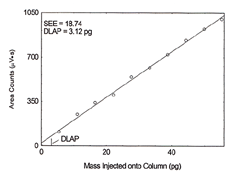
Figure 4.1. Plot of data in Table 4.1 used to
determine the DLAP. (y = 18.0x + 22.8) |
| concentration
(ng/mL) |
mass on column
(pg) |
area
counts
(µV-s) |
|
0
105
211
316
422
527
633
738
844
949
1050 |
0
5.5
11.1
16.6
22.2
27.7
33.3
38.8
44.4
49.9
55.3 |
0
111
249
341
402
545
618
722
835
924
1001 |
| 4.2
Detection limit of the overall procedure (DLOP) and reliable
quantitation limit (RQL)
DLOP is measured as mass per
sample and expressed as equivalent air concentrations, based on
the recommended sampling parameters. Ten samplers were spiked with
equal descending increments of analyte, such that the highest
sampler loading was 1050 ng/sample. This is the amount spiked on a
sampler that would produce a peak approximately 10 times the
response of a sample blank. These spiked samplers, and the sample
blank were analyzed with the recommended analytical parameters,
and the data obtained used to calculate the required parameters
(standard error of estimate and the slope) for the calculation of
the DLOP. Values of 0.940 and 11.90 were obtained for the slope
and standard error of estimate for charcoal tubes, respectively.
The DLOP for charcoal tubes was calculated to be 38 ng/sample (1
ppb). Values of 0.958 and 15.58 were obtained for the slope and
standard error of estimate for SKC 575-002 Passive Samplers,
repsectively. The DLOP for SKC 575-002 Passive Samplers was
calculated to be 49 ng/sample (4 ppb). Values of 0.918 and 12.45
were obtained for the slope and standard error of estimate for 3M
3520 OVMs, respectively. The DLOP for 3M 3520 OVMs was calculated
to be 41 ng/sample (1 ppb).
Table 4.2.1
Detection Limit of the Overall
Procedure
on Charcoal Tubes |
|
|
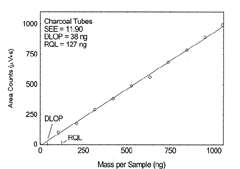
Figure 4.2.1. Plot of data in Table
4.2.1 used to determine the DLOP/RQL of benzene collected
on charcoal tubes (lot 2000). (y = 0.904x + 8.80) |
| mass per sample
(ng) |
area counts
(µV-s) |
|
0
105
211
316
422
527
633
738
844
949
1050 |
0
103
175
293
383
488
563
683
784
889
992 |
|
Table 4.2.2
Detection Limit of the Overall
Procedure
on SKC 575-002 Passive Samplers |
|
|
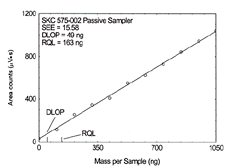
Figure 4.2.2. Plot of data in Table
4.2.2 used to determine the DLOP/RQL of benzene collected
on SKC 575-002 Passive Samplers. (y = 0.958x + 30.0) |
| mass per sample
(ng) |
area counts
(µV·s) |
|
0
105
211
316
422
527
633
738
844
949
1050 |
0
114
255
346
409
551
623
728
841
944
1040 |
|
Table 4.2.3
Detection Limit of the Overall
Procedure on 3M 3520 OVMs |
|
|
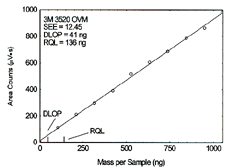
Figure 4.2.3. Plot of
data in Table 4.2.3 used to determine the DLOP/RQL of
benzene collected on 3M 3520 OVMs. (y = 0.918x +
11.5) |
| mass
per sample (ng) |
area
counts (µV·s) |
|
0
105
211
316
422
527
633
738
844
949
1050 |
0
111
211
296
391
517
606
687
786
862
982 |
|
The RQL is
considered the lower limit for precise quantitative
measurements. It is determined from the regression line
parameters obtained for the calculation of the DLOP, providing
75% to 125% of the analyte is recovered. The RQLs for the
various media are listed in Table 4.2.4.
Table 4.2.4
Reliable Quantitation
Limits
|
| sampler |
ng |
ppb |
µg/m³ |
EE |
|
charcoal tube
SKC 575-002
3M 3520 |
127
163
136 |
3.32
4.26
3.55 |
10.6
13.6
11.3 |
96.6
93.1
97.9 |
|
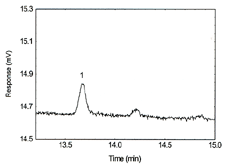 |
| Figure 4.2.4.
Chromatogram of the benzene peak near the RQL on charcoal
tubes, and the peak has an area count of
174. | 4.3
Instrument calibration
The standard error of estimate was
determined from the linear regression of data points from
standards over a range that covers 0.25 to 2 times the TWA target
concentration. A calibration curve was constructed and shown in
Section 3.5.2 from the six injections of five standards. The
standard error of estimate is 0.34 µg.
Table 4.3
Instrument
Calibration
|
| standard concn µg/mL |
area counts
(µV·s) |
|
9.9
19.8
39.5
59.3
79.1 |
14230
26684
53374
80390
107770 |
14187
26783
53487
80450
108450 |
14329
26645
53380
80334
107689 |
14284
26743
53409
80299
107651 |
14229
26523
53312
80387
107743 |
14219
26589
53287
80401
107812 |
|
4.4 Precision
(overall procedure)
4.4.1 Charcoal tubes
The
precision at the 95% confidence level is obtained by multiplying
the standard error of estimate by 1.96 (the z-statistic from the
standard normal distribution at the 95% confidence level). In
Section 4.5, 95% confidence intervals are drawn about their
respective regression lines in the storage graph figures. The
precision of the overall procedure of ±9.94 % was obtained from
the standard error of estimate of 5.07% in Figure 4.5.1.1. The
precision includes an additional 5% for sampling
error.
4.4.2 SKC 575-002 Passive Samplers
The
precisions of the overall procedure at the 95% confidence level
for the ambient temperature 19-day storage test (at the target
concentration) from SKC 575-002 Passive Samplers are given in
Table 4.4.2. They each include an additional 8.7% for sampling
rate variability. There are different values given, depending on
whether both, either, or neither temperature (T) or atmospheric pressure (P) are known at the sampling site. If the
sampling site temperature is unknown, it is assumed to be 22.2 ±
15°C (72 ± 27°F) and a variability of ±7.7% is included. If the
atmospheric pressure is not known, it is estimated from the
sampling site elevation and a variability of ±3% is
included.
Table 4.4.2
Standard Error of
Estimate and Precision of the
Overall Procedure for
SKC 575-002 Passive Samplers
|
| know
condition |
error (%) |
precision (±%) |
|
both
T & P
only T
only P
neither T nor P |
8.75
9.25
11.65
12.03 |
17.2
18.1
22.8
23.6 |
|
4.4.3 3M 3520
OVMs
The precisions of the overall procedure at the
95% confidence level for the ambient temperature 19-day storage
test (at the target concentration) from 3M 3520 OVMs are given
in Table 4.4.3. They each include an additional 6.4% for
sampling rate variability. There are different values given,
depending on whether both, either, or neither temperature (T) or atmospheric pressure (P) are known at the sampling site. If the
sampling site temperature is unknown, it is assumed to be 22.2 ±
15°C (72 ± 27°F) and a variability of ±7.7% is included. If the
atmospheric pressure is not known, it is estimated from the
sampling site elevation and a variability of ±3% is
included.
Table 4.4.3
Standard Error of
Estimate and Precision
of the Overall Procedure for
3M 3520 OVMs
|
| know
condition |
error (%) |
precision (±%) |
|
both
T & P
only T
only P
neither T nor P |
6.45
7.11
10.0
10.5 |
12.6
13.9
19.6
20.6 |
| 4.5
Storage test
4.5.1 Charcoal
tubes
Storage samples for benzene were prepared by
collecting samples from a controlled test atmosphere using the
recommended sampling conditions. The concentration of benzene
was at the target concentration and the absolute humidity was
15.7 milligrams of water per liter of air (about 80% at 22.2°C).
Thirty-three storage samples were prepared. Three samples were
analyzed on the day of generation. Fifteen of the tubes were
stored at reduced temperature (4°C) and the other fifteen were
stored in a closed drawer at ambient temperature (about 22°C).
At 2-5 day intervals, three samples were selected from each of
the two storage sets and analyzed. Sample results are not
corrected for extraction efficiency.
Table 4.5.1
Storage Test for Benzene
on Charcoal Tubes
|
| time
(days) |
ambient storage recovery (%) |
refrigerated storage recovery (%) |
|
0
5
8
12
15
19 |
98.9
99.4
97.9
98.1
98.5
96.8 |
99.9
98.9
99.4
99.9
98.9
99.1 |
100.4
97.9
99.1
97.9
96.9
98.4 |
98.9
98.8
99.5
100.1
97.7
97.9 |
99.9
100.3
100.4
99.9
99.1
99.8 |
100.4
99.7
98.8
97.9
98.5
98.4 |
|
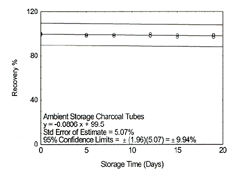 |
| Figure 4.5.1.1. A
plot of the storage data in Table 4.5.1 for benzene under
ambient conditions collected on charcoal
tubes. |
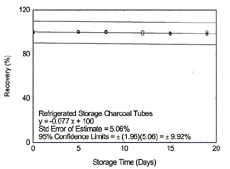 |
Figure 4.5.1.2. Refrigerated
storage test
for benzene collected on charcoal
tubes. |
4.5.2 SKC 575-002 Passive
Samplers
Storage samples for benzene were prepared by
collecting samples from a controlled test atmosphere using the
recommended sampling conditions. The concentration of benzene
was at the target concentration and the absolute humidity was
15.7 milligrams of water per liter of air (about 80% at 22.2°C).
Thirty-three storage samples were prepared. Three samples were
analyzed on the day of generation. Fifteen of the samplers were
stored at reduced temperature (4°C) and the other fifteen were
stored in a closed drawer at ambient temperature (about 22°C).
At 2-5 day intervals, three samples were selected from each of
the two storage sets and analyzed. Sample results are not
corrected for extraction efficiency.
Table 4.5.2
Storage Test for Benzene
on SKC 575-002 Passive Samplers
|
| time
(days) |
ambient storage recovery (%) |
refrigerated storage recovery (%) |
|
0
5
8
12
15
19 |
100.5
99.6
99.4
97.9
96.6
97.5 |
100.6
100.1
98.8
98.8
98.6
96.5 |
98.9
98.8
96.8
98.2
96.1
95.8 |
100.5
99.3
99.9
100.1
98.9
99.3 |
100.6
99.4
99.1
98.6
99.6
97.5 |
98.9
100.3
98.8
99.5
97.5
99.1 |
|
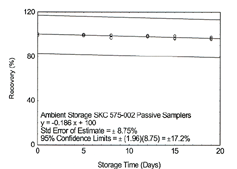 |
| Figure 4.5.2.1. A
plot of the storage data in Table 4.5.2 for benzene under
ambient conditions collected on SKC 575-002 Passive
Samplers. |
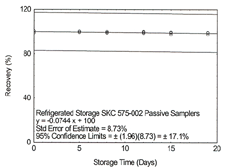 |
| Figure 4.5.2.2. A
plot of the storage data in Table 4.5.2 for benzene under
refrigerated conditions collected on SKC 575-002 Passive
Samplers. |
4.5.3
3M 3520 OVMs
Storage samples for benzene were prepared by
collecting samples from a controlled test atmosphere using the
recommended sampling conditions. The concentration of benzene
was at the target concentration and the absolute humidity was
15.7 milligrams of water per liter of air (about 80% at 22.2°C).
Thirty-three storage samples were prepared. Three samples were
analyzed on the day of generation. Fifteen of the samplers were
stored at reduced temperature (4°C) and the other fifteen were
stored in a closed drawer at ambient temperature (about 22°C).
At 2-5 day intervals, three samples were selected from each of
the two storage sets and analyzed. Sample results are not
corrected for extraction efficiency.
Table 4.5.3
Storage Test for Benzene
on 3M 3520 OVMs
|
| time (days) |
ambient
storage
recovery (%) |
refrigerated
storage recovery (%) |
|
0
5
8
12
15
19 |
100.1
98.6
99.1
96.2
97.2
96.6 |
99.2
99.1
97.8
98.9
95.9
95.5 |
98.2
97.8
98.3
97.1
97.2
95.9 |
100.1
99.9
98.6
99.1
98.5
99.3 |
99.2
98.2
98.9
97.6
99.2
98.5 |
98.2
97.9
96.8
97.8
97.2
97.3 |
|
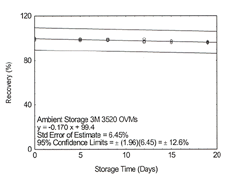 |
| Figure
4.5.3.1. A plot of the storage data in Table 4.5.3
for benzene under ambient conditions collected on 3M 3520
OVMs. |
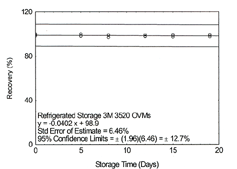 |
| Figure 4.5.3.2. A
plot of the storage data in Table 4.5.3 for benzene under
ambient conditions collected on 3M 3520
OVMs. | 4.6 Reproducibility
Six samples were prepared
for the three types of samplers by collecting them from a
controlled test atmosphere similar to that which was used in the
collection of the storage samples. The samples were submitted to
the OSHA Salt Lake Technical Center for analysis, along with a
draft copy of this method. The samples were analyzed after being
stored for 7 days at 4°C. Sample results were corrected for
extraction efficiency. No sample result for benzene had a
deviation greater than the precision of the overall procedure
determined in Section 4.4.
Table 4.6.1
Reproducibility Data for
Benzene on Charcoal Tubes
|
| theoretical
(µg/sample) |
recovered
(µg/sample) |
recovery (%) |
deviation
(%) |
|
76.91
83.34
77.84
88.56 |
73.61
81.58
75.17
85.62 |
95.7
97.9
96.6
96.7 |
-4.3
-2.1
-3.4
-3.3 |
|
Table 4.6.2
Reproducibility
Data for Benzene on SKC
575-002 Passive Samplers
|
| theoretical (µg/sample) |
recovered (µg/sample) |
recovery (%) |
deviation (%) |
|
26.38
26.38
26.38
26.38
26.38 |
25.62
25.03
25.43
25.21
26.01 |
97.1
94.9
96.4
95.6
98.5 |
-2.9
-5.1
-3.6
-4.4
-1.5 |
|
Table 4.6.3
Reproducibility
Data for Benzene on
3M 3520 OVMs
|
| theoretical (µg/sample) |
recovered (µg/sample) |
recovery (%) |
deviation (%) |
|
58.52
58.52
58.52
58.52
58.52
58.52 |
56.53
56.18
55.95
57.06
55.59
57.01 |
96.6
96.0
95.6
97.5
95.0
97.4 |
-3.4
-4.0
-4.4
-2.5
-5.0
-2.6 |
|
4.7 Sampler
capacity
4.7.1 Charcoal tubes
The
sampling capacity of the front section of a charcoal tube was
tested by sampling from a dynamically generated test atmosphere
of benzene (72.8 mg/m³ or 23 ppm) with an absolute humidity of
15.7 milligrams of water per liter of air (about 80% relative
humidity at 22.2°C). This air concentration was twice the
highest PEL. The samples were collected along with diffusive
samplers. Three charcoal tubes and three of each kind of
diffusive samplers were collected at 5, 10, 15, and 30 min, and
1, 2, 3, 4, 6, 8, and 10 hours. The charcoal tube samples were
collected at 50 mL/min. There was no breakthrough observed in
any of the charcoal tubes, therefore the sampler capacity was
never exceeded. The interference study of gasoline showed that
for samples taken up to 8 hours, with a benzene concentration of
32 mg/m³ or 10 ppm, and a gasoline concentration of 890 mg/m³
had no breakthrough for the benzene, though the gasoline did
breakthrough after 4 hours (Section 4.9).
4.7.2 SKC
575-002 Passive Samplers
The sampling rate and sampler
capacity are determined with samples collected for increasing
time intervals from a controlled test atmosphere. Sampler
capacity is exceeded when the sampling rate decreases (greater
than 10 hours for SKC 575-002). The concentration of the test
atmosphere was two times the target concentration with an
absolute humidity of 15.7 milligrams of water per liter of air
(about 80% at 22.2°C). The preliminary sampling rate was
determined by averaging the nine values for the 0.5, 1 and 2 h
samples. Horizontal lines were placed 10% above and below the
preliminary sampling rate. For an atmosphere of 2.3 ppm the
sampling rate is 17.2 mL/min at 760 mmHg and 25°C and represents
the average of all values between the lines. The standard
deviation and RSD are 0.453 mL/min and 2.63%, respectively. For
an atmosphere of 23 ppm the sampling rate is 16.9 mL/min at 760
mmHg and 25 °C and represents the average of all values between
the lines. The standard deviation and RSD are 0.411 mL/min and
2.43%, respectively. The average sampling rate from both
determinations was 17.1 mL/min. The data obtained are shown in
Table 4.7.2.1 and Figure 4.7.2.1. Mass collected is corrected
for extraction efficiency. The sampling rate for a 5-minute
sample is significantly different from the calculated sampling
rate indicating that samples should not be taken for that short
of a time. The recommended sampling time is 4 h for TWA samples,
10 min for Peak samples, and 15 min for STEL samples.
Table 4.7.2.1
Determination of
Sampling Rate
and Time for SKC 575-002
Passive
Samplers from a 2.3-ppm Atmosphere
|
|
sampling rate (mL/min)
|
| time (h) |
first |
second |
third |
|
0.083
0.167
0.25
0.5
1
2
3
4
6
8
10 |
19.2
18.3
18.0
17.8
17.2
16.9
16.2
16.3
16.4
16.2
16.0 |
19.0
18.6
17.9
17.5
17.3
16.8
16.8
16.1
16.2
16.5
16.1 |
18.8
18.4
18.1
17.7
17.4
16.4
16.3
16.0
16.3
16.1
15.9 |
|
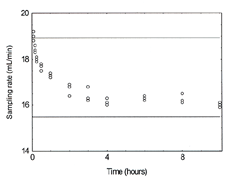 |
| Figure
4.7.2.1. This is a plot of the data in Figure
4.7.2.1 of time versus sampling rate, used to determine
the recommended sampling time and sampling rate from a
2.3-ppm atmosphere for SKC 575-002 Passive
Samplers. |
Table 4.7.2.2
Determination of
Sampling Rate and Time for SKC 575-002 Passive Samplers from a
23-ppm Atmosphere
|
|
sampling rate (mL/min)
|
| time (h) |
first |
second |
third |
|
0.083
0.167
0.25
0.5
1
2
3
4
6
8
10 |
18.4
18.0
17.4
17.2
16.7
16.5
16.1
16.4
16.4
16.4
16.3 |
18.5
17.7
17.7
17.4
16.5
16.3
16.3
16.1
16.3
16.1
16.0 |
18.2
17.9
17.6
16.9
16.9
16.9
16.5
16.6
16.2
16.0
16.1 |
|
 |
| Figure 4.7.2.2. This
is a plot of the data in Figure 4.7.2.2 of time versus
sampling rate, used to determine the recommended sampling
time and sampling rate from a 23-ppm atmosphere for SKC
575-002 Passive Samplers. |
4.7.3 3M 3520 OVMs
The sampling rate and
sampler capacity are determined with samples collected for
increasing time intervals from a controlled test atmosphere.
Sampler capacity is exceeded when the sampling rate decreases
(greater than 10 hours for 3M 3520 OVMs). The concentration of
the test atmosphere was two times the target concentration with
an absolute humidity of 15.7 milligrams of water per liter of
air (about 80% at 22.2°C). The preliminary sampling rate was
determined by averaging the nine values for the 0.5, 1 and 2 h
samples. Horizontal lines were placed 10% above and below the
preliminary sampling rate. For an atmosphere of 2.3 ppm the
sampling rate is 34.3 mL/min at 760 mmHg and 25°C and represents
the average of all values between the lines. The standard
deviation and RSD are 0.771 mL/min and 2.25%, respectively. The
data obtained are shown in Table 4.7.3.1 and Figure 4.7.3.1. For
an atmosphere of 23 ppm the sampling rate is 34.3 mL/min at 760
mmHg and 25 °C and represents the average of all values between
the lines. The standard deviation and RSD are 0.466 mL/min and
1.36%, respectively. The data obtained are shown in Table
4.7.3.2 and Figure 4.7.3.2. Mass collected is corrected for
extraction efficiency. The recommended sampling time is 4 h for
TWA samples, 10 min for Peak samples, and 15 min for STEL
samples.
Table 4.7.3.1
Determination of
Sampling Rate and Time for 3M 3520 OVMs from a 2.3-ppm
Atmosphere
|
|
sampling rate (mL/min)
|
| time (h) |
first |
second |
third |
|
0.083
0.167
0.25
0.5
1
2
3
4
6
8
10 |
36.2
35.6
35.1
34.4
34.5
33.5
34.1
34.2
32.6
34.5
34.3 |
36.3
35.9
35.8
35.9
34.1
33.6
33.5
34.4
33.9
33.2
33.8 |
36.6
35.8
35.4
34.9
33.8
33.7
33.2
34.1
33.7
33.9
33.9 |
|
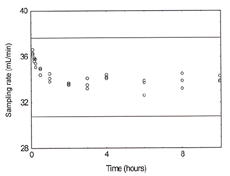 |
| Figure
4.7.3.1. This is a plot of the data in Figure
4.7.3.1 of time versus sampling rate, used to determine
the recommended sampling time and sampling rate from a
2.3-ppm atmosphere for 3M 3520
OVMs. |
Table 4.7.3.2
Determination of
Sampling Rate and Time for 3M 3520 OVMs from a 23-ppm
Atmosphere
|
|
sampling rate (mL/min)
|
| time (h) |
first |
second |
third |
|
0.083
0.167
0.25
0.5
1
2
3
4
6
8
10 |
36.8
35.5
35.2
34.0
34.1
33.9
33.9
33.8
34.1
34.3
34.2 |
36.0
35.0
35.6
35.2
34.4
34.5
34.2
33.9
33.7
33.8
33.6 |
36.4
35.7
35.3
34.7
33.9
34.2
33.8
34.5
34.3
34.8
33.8 |
|
 |
| Figure
4.7.3.2. This is a plot of the data in Figure
4.7.3.2 of time versus sampling rate, used to determine
the recommended sampling time and sampling rate from a
23-ppm atmosphere for 3M 3520
OVMs. | 4.8 Extraction efficiency and stability of extracted
samples
The extraction efficiency is dependent on the
extraction solvent as well as the internal standard. The
extraction solvent used for this evaluation consisted of 0.25
µL/mL n-hexylbenzene (1-phenylhexane) in the CS2. Other
extraction solvents or internal standards may be used provided
that the new extraction solution or internal standard is tested.
The new extraction solvent or internal standard should be tested
as described below.
4.8.1 Charcoal
tubes
Extraction efficiency
The extraction
efficiencies of benzene were determined by liquid-spiking four
charcoal tubes, at each concentration level, with the analyte
from the RQL to 2 times the target concentration. These samples
were stored overnight at ambient temperature and then analyzed.
The mean extraction efficiency over the working range of the RQL
to 2 times the target concentration is 97.0%. The extraction
efficiency for the wet samplers was not included in the overall
mean because it would bias the results. The test of wet samplers
was performed to determine if the amount of water, that would
collect under high humidity conditions at the recommended air
volume, would affect the extraction efficiency.
Table 4.8.1.1
Extraction Efficiency
of Benzene from Charcoal Tubes
|
level
|
sample number
|
|
| ×
target concn |
µg per sample |
1 |
2 |
3 |
4 |
mean |
|
RQL
0.25
0.5
1.0
1.5
2.0
1.0
(wet) |
0.13
9.9
19.8
39.5
59.3
79.1
39.5 |
98.5
98.6
97.6
96.7
96.9
97.2
97.1 |
97.3
95.3
98.2
97.1
95.5
96.5
95.6 |
95.3
96.6
97.6
96.3
96.9
97.2
96.8 |
95.1
97.3
98.2
97.0
97.3
97.1
97.2 |
96.6
97.0
97.9
96.8
96.7
97.0
96.7 |
|
Stability of
extracted samples
The stability of extracted samples was
investigated by reanalyzing the target concentration samples 24
h after initial analysis. After the original analysis was
performed two vials were recapped with new septa while the
remaining two retained their punctured septa. The samples were
reanalyzed with fresh standards. The average percent change was
0.9% for samples that were resealed with new septa and 3.4% for
those that retained their punctured septa. Each septum was
punctured 5 times for each injection. The test was performed at
room temperature.
Table 4.8.1.2
Stability Samples for
Benzene on Charcoal Tubes
|
punctured septa replaced
|
punctured septa retained
|
initial
(%) |
after one day
(%) |
difference
(%) |
initial
(%) |
after one day
(%) |
difference
(%) |
|
96.7
97.1
96.9 |
95.6
96.3
(mean)
96.0 |
-1.1
-0.8
-0.9 |
96.3
97.0
96.7 |
92.1
94.5
(mean)
93.3 |
-4.2
-2.5
-3.4 |
|
4.8.2 SKC
575-002 Passive Sampler
Extraction efficiency
The
extraction efficiencies of benzene were determined by
liquid-spiking four SKC 575-002 Passive Samplers, at each
concentration level, with the analyte at the RQL to 2 times the
target concentration. These samples were stored overnight at
ambient temperature and then extracted and analyzed. The average
extraction efficiency over the working range of RQL to 2 times
the target concentration was 93.6%. The extraction efficiency
for the wet samplers was not included in the overall mean
because it would bias the results. The test of wet samplers was
performed to determine if the amount of water, that would
collect under high humidity conditions at the recommended air
volume, would affect the extraction efficiency.
Table 4.8.2.1
Extraction Efficiency
of Benzene
from SKC 575-002 Passive
Samplers
|
level
|
sample number
|
|
| × target
concn |
µg per
sample |
1 |
2 |
3 |
4 |
mean |
|
RQL
0.25
0.5
1.0
1.5
2.0
1.0
(wet) |
0.13
3.08
6.15
12.3
18.5
24.6
12.3
|
93.8
95.2
93.3
94.9
92.4
94.2
93.5
|
92.4
94.3
94.3
93.6
93.8
93.4
94.5
|
91.4
93.4
93.8
94.3
93.5
94.2
93.6
|
94.6
93.1
92.6
92.2
93.3
93.1
94.0
|
93.1
94.0
93.5
93.8
93.3
93.7
93.9 |
|
Stability of
extracted samples
The stability of extracted samples was
investigated by reanalyzing the target concentration samples 24
h after initial analysis. After the original analysis was
performed two vials were recapped with new septa while the
remaining two retained their punctured septa. The samples were
reanalyzed with fresh standards. The average percent change was
1.3% for samples that were resealed with new septa and 2.6% for
those that retained their punctured septa. Each septum was
punctured 5 times for each injection. The test was performed at
room temperature.
Table 4.8.2.2
Stability of Extracted
Samples for
Benzene on SKC 575-002 Passive
Samplers
|
punctured septa replaced
|
punctured septa retained
|
initial
(%) |
after one day
(%) |
difference
(%) |
initial
(%) |
after one day
(%) |
difference
(%) |
|
94.9
93.6
94.3 |
93.1
92.8
(mean)
93.0 |
-1.8
-0.8
-1.3 |
94.3
92.2
93.3 |
91.2
90.2
(mean)
90.7 |
-3.1
-2.0
-2.6 |
|
4.8.3 3M 3520
OVMs
Extraction efficiency
The extraction
efficiencies of benzene were determined by liquid-spiking four
3M 3520 OVMs, at each concentration level, with the analyte at
the RQL to 2 times the target concentration. These samples were
stored overnight at ambient temperature and then extracted and
analyzed. The average extraction efficiency over the working
range of RQL to 2 times the target concentration was 97.9%. The
extraction efficiency for the wet samplers was not included in
the overall mean because it would bias the results. The test of
wet samplers was performed to determine if the amount of water,
that would collect under high humidity conditions at the
recommended air volume, would affect the extraction
efficiency.
Table 4.8.3.1
Extraction Efficiency
of Benzene from 3M 3520 OVMs
|
level
|
sample number
|
|
| × target
concn |
µg per
sample |
1 |
2 |
3 |
4 |
mean |
|
RQL
0.25
0.5
1.0
1.5
2.0
1.0
(wet) |
0.13
6.81
13.6
27.2
40.9
54.5
27.2 |
98.5
97.4
97.3
97.2
98.0
98.4
98.4 |
97.7
98.1
98.8
98.2
97.6
98.0
97.9 |
98.2
97.7
97.8
97.4
97.7
98.6
97.7 |
97.2
97.8
98.1
98.5
98.1
97.8
98.2 |
97.9
97.8
98.0
97.8
97.9
98.2
98.1 |
|
Stability of
extracted samples
The stability of extracted samples was
investigated by reanalyzing the target concentration samples 24
h after initial analysis. After the original analysis was
performed two vials were recapped with new septa while the
remaining two retained their punctured septa. The samples were
reanalyzed with fresh standards. The average percent change was
0.6% for samples that were resealed with new septa and 1.9% for
those that retained their punctured septa. Each septum was
punctured 5 times for each injection. The test was performed at
room temperature.
Table 4.8.3.2
Stability of Extracted
Samples
for Benzene on 3M 3520 OVMs
|
punctured septa replaced
|
punctured septa retained
|
initial
(%) |
after one day
(%) |
difference
(%) |
initial
(%) |
after one day
(%) |
difference
(%) |
|
97.2
98.2
97.7 |
96.1
98.0
(mean)
97.1 |
-1.1
-0.2
-0.6 |
97.4
98.5
98.0 |
95.9
96.3
(mean)
96.1 |
-1.5
-2.2
-1.9 |
| 4.9
Interferences (sampling)
4.9.1 Charcoal
tubes
Retention
The ability of a charcoal tube to
retain benzene after it has been collected was tested by
sampling an atmosphere containing 73.4 mg/m³ of benzene at an
absolute humidity of 15.7 milligrams of water per liter of air
(about 80% relative humidity at 22.2°C). Six samplers had
contaminated air drawn through them at 50 mL/min for 60 min.
Sampling was discontinued and three samples set aside. The
generation system was flushed with contaminant-free air.
Sampling resumed with the other three samples having
contaminant-free air drawn through them at 50 mL/min for 180 min
and then all six samplers were analyzed. The mean of the samples
in the second set had retained more than 100.4% of the mean
collected by the first three samples.
Table 4.9.1
Retention of Benezene on
Charcoal tubes
|
|
percent recovery (%) |
|
| set |
1 |
2 |
3 |
mean |
|
first
second
second/first |
98.7
99.1 |
99.2
99.0 |
99.6
100.5 |
99.2
99.5
100.3 |
|
Low
humidity
The ability of a charcoal tube to collect
benzene from a relatively dry atmosphere was tested by sampling
an atmosphere containing 73.4 mg/m³ of benzene at an absolute
humidity of 1.9 milligrams of water per liter of air (about 10%
relative humidity at 22.2°C). Three samplers had contaminated
air drawn through them at 50 mL/min for 240 min. All of the
samples were immediately analyzed. The samples had collected
99.4%, 99.8% and 99.7% of theoretical.
Low
concentration
The ability of a charcoal tube to collect
benzene at low concentrations was tested by sampling an
atmosphere containing 0.32 mg/m³ of benzene at an absolute
humidity of 15.7 milligrams of water per liter of air (about 80%
relative humidity at 22.2°C). The benzene concentration was
achieved by diluting the benzene with toluene and pumping the
mixture into the sampling chamber. Three samplers had
contaminated air drawn through them at 50 mL/min for 240 min.
All of the samples were immediately analyzed. The samples had
collected 100.4%, 98.5% and 98.9% of
theoretical.
Interference
The ability of a
charcoal tube to collect benzene was tested when other potential
interferences are present by sampling an atmosphere containing
31.9 mg/m³ of benzene at an absolute humidity of 15.7 milligrams
of water per liter of air (about 80% relative humidity at
22.2°C) and gasoline, whose concentration was 890 mg/m³. Three
samplers had contaminated air drawn through them at 50 mL/min
for 240 min. All of the samples were immediately analyzed. The
samples had collected 99.8%, 100.1% and 98.9% of theoretical.
There was no benzene on the backup portion of the charcoal
tubes, though there was 5.25% gasoline.
4.9.2 SKC 575-002
Passive Sampler
Reverse diffusion
Reverse
diffusion is the measure of the ability of the sorbent within a
diffusive sampler to retain the analyte collected. Reverse
diffusion is measured by first exposing two sets of samplers to
humid air containing the analyte, and then additionally exposing
one of the sets to clean humid air of an absolute humidity of
15.7 milligrams of water per liter of air (about 80% relative
humidity at 22.2°C). Six samplers were exposed to contaminated
air for 60 min. Sampling was discontinued and three samples set
aside. The generation system was flushed with contaminant-free
air. Sampling resumed with the other three samples being exposed
to humid contaminant-free air for 180 min and then all six
samplers were analyzed. Comparison of the two sets of SKC
575-002 Passive Samplers showed that an average of 99.1% of the
benzene was retained, indicating a loss of 0.9% to reverse
diffusion. The loading of benzene on the samplers was 75.3
µg.
Table 4.9.2
Reverse Diffusion of
Benzene on
SKC 575-002 Passive Samplers
|
|
mass
(µg) |
|
| set |
1 |
2 |
3 |
mean |
|
first
second
second/first |
75.6
74.1 |
75.2
74.7 |
75.8
75.5 |
75.5
74.8
99.1% |
|
Low
humidity
The ability of a SKC 575-002 Passive Sampler to
collect benzene from a relatively dry atmosphere was tested by
sampling an atmosphere containing 73.4 mg/m³ of benzene at an
absolute humidity of 1.9 milligrams of water per liter of air
(about 10% relative humidity at 22.2°C). Three samplers were
exposed to contaminated air for 240 min. All of the samples were
immediately analyzed. The samples had collected 99.2%, 98.9% and
100.3% of theoretical.
Low concentration
The
ability of a SKC 575-002 Passive Sampler to collect benzene at
low concentration was tested by sampling an atmosphere
containing 0.32 mg/m³ of benzene at an absolute humidity of 15.7
milligrams of water per liter of air (about 80% relative
humidity at 22.2°C). The benzene concentration was achieved by
diluting the benzene with toluene and pumping the mixture into
the sampling chamber. Three samplers were exposed to
contaminated air for 240 min. All of the samples were
immediately analyzed. The samples had collected 100.3%, 98.7%
and 99.8% of theoretical.
Interference
The ability
of a SKC 575-002 Passive Sampler to collect benzene when other
potential interferences are present was tested by sampling an
atmosphere containing 31.9 mg/m³ of benzene at an absolute
humidity of 15.7 milligrams of water per liter of air (about 80%
relative humidity at 22.2°C) and gasoline, whose concentration
was 890 mg/m³. Three samplers were exposed to contaminated air
for 240 min. All of the samples were immediately analyzed. The
samples had collected 99.3%, 100.3% and 99.8% of
theoretical.
4.9.3 3M 3520 OVMs
Reverse
diffusion
Reverse diffusion is the measure of the ability
of the sorbent within a diffusive sampler to retain the analyte
collected. Reverse diffusion is measured by first exposing two
sets of samplers to humid air containing the analyte, and then
additionally exposing one of the sets to clean humid air of an
absolute humidity of 15.7 milligrams of water per liter of air
(about 80% relative humidity at 22.2°C). Six samplers were
exposed to contaminated air for 60 min. Sampling was
discontinued and three samples set aside. The generation system
was flushed with contaminant-free air. Sampling resumed with the
other three samples being exposed to humid contaminant-free air
for 180 min and then all six samplers were analyzed. Comparison
of the two sets of 3M 3520 OVMs showed that an average of 99.2%
of the benzene was retained, indicating a loss of 0.8% to
reverse diffusion. The loading of benzene on the samplers was
75.3 µg.
Table 4.9.3
Reverse Diffusion of
Benzene on 3M 3520 OVMs
|
|
mass
(µg) |
|
| set |
1 |
2 |
3 |
mean |
|
first
second
second/first |
150.8
150.6 |
150.2
149.0 |
150.9
148.5
|
150.6
149.4
99.2 |
|
Low
humidity
The ability of a 3M 3520 OVM to collect benzene
from a relatively dry atmosphere was tested by sampling an
atmosphere containing 73.4 mg/m³ of benzene at an absolute
humidity of 1.9 milligrams of water per liter of air (about 10%
relative humidity at 22.2°C). Three samplers were exposed to
contaminated air for 240 min. All of the samples were
immediately analyzed. The samples had collected 99.9%, 98.7% and
100.2% of theoretical.
Low concentration
The
ability of a 3M 3520 OVM to collect benzene at low concentration
was tested by sampling an atmosphere containing 0.32 mg/m³ of
benzene at an absolute humidity of 15.7 milligrams of water per
liter of air (about 80% relative humidity at 22.2 °C). The
benzene concentration was achieved by diluting the benzene with
toluene and pumping the mixture into the sampling chamber. Three
samplers were exposed to contaminated air for 240 min. All of
the samples were immediately analyzed. The samples had collected
99.7%, 99.5% and 100.6% of
theoretical.
Interference
The ability of a 3M 3520
OVM to collect benzene when other potential interferences are
present was tested by sampling an atmosphere containing 31.9
mg/m³ of benzene at an absolute humidity of 15.7 milligrams of
water per liter of air (about 80% relative humidity at 22.2°C)
and gasoline, whose concentration was 890 mg/m³. Three samplers
were exposed to contaminated air for 240 min. All of the samples
were immediately analyzed. The samples had collected 100.1%,
100.3% and 99.1% of theoretical. There was no benzene on the
backup pad of the sampler, though there was 2.75% of the
gasoline. 4.10 Qualitative
analysis
The identity of benzene may be confirmed by
GC/mass spectrometry. The mass spectrum of benzene is in Figure
4.10.
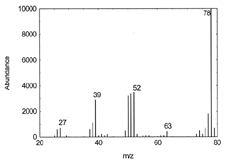 |
| Figure 4.10. This is a plot
of the mass spectrum of benzene. The major peaks are: a
base peak (highest abundance peak) of 78 amu, the next
highest are a triplet at 50, 51, and 52 amu, followed in
intensity by 39,27, 38, and
77. |
5. Addendum for 1005: Wipe sampling for
Benzene
Introduction
Benzene is a volatile organic
solvent which will not collect onto the conventional wipe media of
filters, ie. Smear tabs or Whatman filters, as it will
evaporate off of these media within minutes of sampling. The
charcoal pad from a 3M 3500 or 3520 Organic Vapor Monitor (OVM)
was found to adsorb the benzene and retain it upon storage when
placed in a tightly sealed vial. Note that an obviously dry
surface will have no benzene on it, as the benzene will have
already evaporated away. Wipe samples should be taken from
surfaces where a residue of some sort can be
observed.
The charcoal pads need to remain in a
sealed container until just before use, and need to be placed
immediately into a sealed container after sampling, as the
charcoal pad can also adsorb organic vapors from the air. It is
possible to remove the charcoal pads, in the office, from the 3M
OVM and place in a 20-mL tightly capped sample vial, and take the
vial to the workplace for sampling. Alternately, the charcoal pads
may be placed in a sealed aluminized plastic bag, until
used.
The charcoal pad may also be used to check for skin
exposure due to the permeation of benzene through the worker’s
gloves. The charcoal pad is placed in the palm of the employees
hand, and the gloves are put on over it. The charcoal pad is
removed when the gloves are changed or removed, immediately placed
in a vial, sealed, and sent in for analysis. If benzene is found
on the charcoal pad, it indicates that benzene permeated the
glove and skin exposure may have occurred.
Wipe
Technique
Prepare a sufficient number of 20-mL sample
vials, or aluminized plastic bags, each labeled with a unique
number, for the projected sampling needs.
Prepare a
diagram of the area or rooms to be wipe sampled along with the
locations of key surfaces.
Wear a new pair of clean gloves
for each sample to prevent contamination of future samples as well
as oneself. The selected gloves are to be resistant to penetration
of the chemical being sampled and any other chemicals expected to
be present. Nitrile gloves are suggested for sampling benzene
based on a review of several glove manufacturer’s chemical
resistivity and degradation information. Do not wear powdered
gloves.
Record the sample vial number and the location
where the sample is taken.
Remove the charcoal pad
from the carrying container with clean tweezers or gloved
hand.
Depending on the purpose of the sample, it may
be useful to determine the surface loading of the contamination
(e.g., in micrograms of analyte per area). For these samples, it
is necessary to record the area of the surface wiped (e.g., 100
cm2). This would not be necessary for samples taken to simply
show the presence of the contaminant.
Surfaces should
not be wetted with water as the water may adsorb along the
benzene, decreasing the capacity of the charcoal pad for
benzene.
Firm pressure should be applied when wiping.
Start at the outside edge and progress toward the center making
concentric squares of decreasing size. Fold the filter with the
contaminant side inward and repeat.
Without allowing
the charcoal pad to come into contact with any other surface, fold
the charcoal pad with the exposed side inward. Place the charcoal
pad in a sample vial and tightly cap it (or place in aluminized
plastic bag and seal it), and place a corresponding number at the
sample location on the diagram. Include notes with the sketch
giving any further description that may prove useful when
evaluating the sample results (e.g., a description of the surface
sampled, such as pencil, doorknob, safety glasses, lunch table,
inside respirator, employee names, etc.).
Submit at
least one blank charcoal pad, treated in the same fashion (ie.
take it out of the original container and place in sample vial or
aluminized plastic bag), but without wiping.
Record sample
location, employees names, surface area (if pertinent), work
description, type of operation, personal protective equipment, and
any other necessary information, along with any potential
interferences on the OSHA-91A
form.
Submit the samples to the OSHA Salt Lake
Technical Center together with OSHA-91A forms as soon as possible
after sampling. Ship any bulk samples separate from the surface
samples.
Results and Discussion
The extraction
studies performed in OSHA Method 1005 for the 3M 3520 OVM pertain
also to these wipe samples. The mean extraction efficiency for
benzene from dry 3M 3520 OVMs over the range of RQL to 2 times the
target concentration (0.13 to 54.5 micrograms per sample) was
97.9% when using carbon disulfide to extract the samples. The
extraction efficiency was not affected by the presence of water
(average recovery of 98.1%).
| The sampler removal efficiency
was evaluated using the ideal surface of a glass plate. This
type of surface approaches the smooth and non-porous
characteristics of an ideal surface. The variety of surfaces
found in workplaces will likely be less than ideal, so the
media will have a lower removal efficiency. The amount
of analyte found on the charcoal pad after sampling will
indicate that at least that amount was present on the
surface that was sampled. The glass plate was spiked with a
solution of benzene in carbon disulfide, and immediately
wiped with the charcoal pad, to avoid loss due to
evaporation from the glass plate. Six surfaces were spiked
at the target concentration of benzene, 25 µg/100 cm2. The
average recovery was 94.1% (Table 5.1). |
Table 5.1
Sampler Removal
Efficiency
Data for Benzene |
|
theoretical
(µg/surface) |
recovered
(µg/sample) |
recovery (%) |
|
25
25
25
25
25
25 |
23.2
24.1
22.9
23.1
24.5
23.4 |
92.8
96.4
91.6
92.4
98.0
93.6 |
| |
The storage studies were performed by spiking a
glass plate with a solution containing benzene, wiping
immediately, and then the charcoal pad was placed into a 20-mL
vial and tightly capped. Three samples were analyzed immediately.
Fifteen of the samples were stored at ambient temperature and
fifteen were stored at refrigerated temperature. The recovery was
93.6% for ambient storage and 95.0% for refrigerated storage
for the fifteen days stored (Table 5.2).
Table
5.2
Storage Test for Benzene |
|
time
(days) |
ambient storage
recovery (%) |
refrigerated storage
recovery (%) |
|
0
4
8
15 |
97.3
96.9
95.8
92.8 |
94.8
95.1
94.3
95.1 |
95.3
95.5
92.4
93.2 |
97.3
95.2
96.1
97.1 |
94.8
96.4
92.9
95.5 |
95.3
93.3
94.5
93.8 |
|
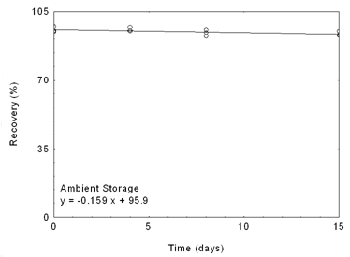
Figure
5.1 This is a plot of the benzene wipe ambient storage
data found in Table 5.2. |
|
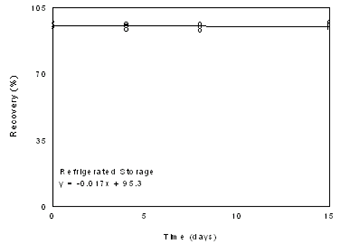
Figure 5.2
This is a plot of the benzene wipe refrigerated storage data
found in Table 5.2. |
Sampling reproducibility studies
were performed by having a chemist, other than the one developing
the method, conduct sampling on the glass plate using the charcoal
pad. The test was repeated with a second chemist performing the
sampling. The samples were analyzed. The first chemist was able to
achieve a removal efficiency of 94.1% and the second chemist 93.3%
(Tables 5.3 and 5.4).
Table 5.3
Sampling Reproducibility
1st
Chemist Samples for Benzene
|
theoretical
(µg/surface) |
recovered
(µg/sample) |
recovery
(%) |
|
25
25
25
25
25
25 |
24.0
23.5
22.6
23.9
24.1
23.1 |
96.0
94.0
90.4
95.6
96.4
92.4 |
| |
Table 5.4
Sampling Reproducibility
2nd
Chemist Samples for Benzene
|
theoretical
(µg/surface) |
recovered
(µg/sample) |
recovery
(%) |
|
25
25
25
25
25
25 |
24.1
22.5
23.9
22.9
23.6
22.9 |
96.4
90.0
95.6
91.6
94.4
91.6 |
| |
| The reproducibility of the
analytical wipe method was tested by taking six samples from
the glass plate and submitting them, with a copy of the
method, to the OSHA SLTC for analysis. The samples were
analyzed after being stored for 10 days at 23 °C. The
average recovery was 94.0% (Table 5.5). |
Table 5.5
Analytical
Reproducibility
Data for Benzene
|
theoretical
(µg/surface) |
recovered
(µg/sample) |
recovery
(%) |
|
25
25
25
25
25
25 |
23.1
24.2
22.8
22.7
23.9
24.3 |
92.4
96.8
91.2
90.8
95.6
97.2 |
| | Conclusion
Wipe samples for benzene can be
collected on charcoal pads. The surface to be sampled should have
some residue on it, as a dry surface will have no benzene on it.
It is important to tightly seal the vials the charcoal pads are
placed in, and to send a blank, as the charcoal pads can absorb
any organic chemical they may come into contact
with.
References
1. OSHA Computerized Information System Database,
Chemical Sampling Information, http://www.osha-slc.gov/index.html,
(accessed August 2001)
2. OSHA Computerized
Information System Database, Chemical Sampling Information, http://www.osha-slc.gov/index.html,
(accessed August 2001)
3. Documentation of the Threshold Limit Values and
Biological Exposure Indices, 6th ed.; American Conference of
Governmental Industrial Hygienists, Inc.: Cincinnati, OH, 1991, Vol.
II, p 108.
4. OSHA Computerized Information
System Database, Chemical Sampling Information, http://www.osha-slc.gov/index.html,
(accessed August 2001)
5. Rinsky, R.A.,
Smith A.B., Hormung R. et al, Benzene and Leukemia: An Epidemiologic
Risk Assessment, N Engl J Med, 1987, 316
(17), pp1044-1050.
6. International Agency for Research on Cancer: Benzene,
IARC Monographs on the Evaluation of Carcinogenic Risk of Chemicals
to Humans, Some Industrial chemicals and Dyestuffs, IARC,
Lyon, France, Vol 29, 1982, pp 93-148.
7.
Documentation of the Threshold Limit Values
and Biological Exposure Indices, 6th ed.; American Conference
of Governmental Industrial Hygienists, Inc.: Cincinnati, OH, 1991,
Vol. II, p 108.
8. Budavari, S., The Merck Index, 12th ed., Merck & Co. Inc.:
Whitehouse Station, NJ, 1996, p 178.
9.
Lewis, R., J., Hawley's Condensed Chemical
Dictionary, 12th ed., Van Nostrand Reinhold Co.: New York,
1997, p 123.
10. McCoy, M. et al., Facts
& Figures for the Chemical Industry, Chem.
Eng. News, 2001, 79 (Jun 25), p 45.
11.
Documentation of the Threshold Limit Values
and Biological Exposure Indices, 6th ed.; American Conference
of Governmental Industrial Hygienists, Inc.: Cincinnati, OH, 1991,
Vol. II, p 108.
12. Lewis, R., J., Hawley's Condensed Chemical Dictionary, 12th
ed., Van Nostrand Reinhold Co.: New York, 1997, p 123.
13. Budavari, S., The Merck
Index, 12th ed., Merck & Co. Inc.: Whitehouse Station,
NJ, 1996, p 178.
14. OSHA Computerized
Information System Database, Chemical Sampling Information, http://www.osha-slc.gov/index.html,
(accessed August 2001)
15. Burright, D.;
Chan, Y.; Eide, M.; Elskamp, C.; Hendricks, W.; Rose, M. C. Evaluation Guidelines for Air Sampling Methods
Utilizing Chromatographic Analysis, http://www.osha-slc.gov/index.html,
(accessed August 2001).
16. Occupational
Exposure to Hazardous Chemicals in Laboratories. Code of Federal Regulations, Part 1910.1450,
Title 29, 1998.
17. Burright, D.; Chan, Y.;
Eide, M.; Elskamp, C.; Hendricks, W.; Rose, M. C. Evaluation Guidelines for Air Sampling Methods
Utilizing Chromatographic Analysis, http://www.osha-slc.gov/index.html,
(accessed August 2001).
|
| |
| |

